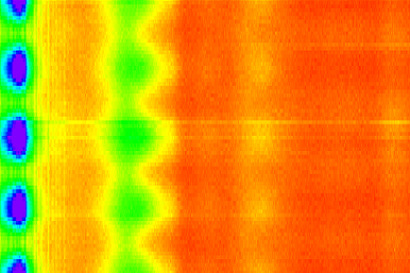Multiferroic materials exhibit simultaneously ferroelectric and magnetic order and can show a strong magnetoelectric coupling. This means that the magnetization can be controlled by an electric field, or the ferroelectric polarization can be influenced by a magnetic field. These phenomena are very promising for magnetoelectric memories, since the application of electric field on memory cells is technically easier than application of the magnetic field. The magnetoelectric memories could be very fast and thus replace the current hard discs or flash memories.
In many multiferroics (so called multiferroics of type I) the magnetic structure develops independently of the ferroelectric order, in this case the magnetoelectric coupling is, as a rule, quite weak. This is the case of e.g. the most studied „high-temperature“ multiferroic BiFeO3, where the linear magnetoelectric coupling is forbidden due to the symmetry of cycloidal antiferromagnetic structure; hence only weak higher order coupling can be at the origin of the magnetoelectric effect.
In multiferroics of type II the magnetically ordered structure directly induces the ferroelectric polarization by an exchange interaction or by the inverse Dzyaloshinski-Moriya interaction. As a result, magnetoelectric coupling can be very strong, allowing e.g. a rotation of the electric polarization in a magnetic field or even a switching of the magnetization by an electric field. However, these materials exhibit the multiferroic order typically at very low temperatures (usually below 100 K). For this reason new multiferroic compounds with critical temperatures above room temperature are intensively searched for and investigated. We are interested in studies of both static magnetoelectric coupling (i.e. change of ferroelectric polarization by magnetic field) and dynamic magnetoelectric coupling activating electromagnons in THz and FIR spectra.
Among others, we are focusing our research on
- ferrimagnetic materials with hexaferrite crystal structures (Y-, W- and Z-type), which exhibit spin-order-induced ferroelectric polarization near or above room temperature, huge static magnetoelectric coupling and strong electromagnons activated by the dynamic magnetoelectric coupling. Electromagnon studies are performed in collaboration with the THz group.
- quadruple perovskites AMn7O12 (A=Ca,Sr,Cd,Pb,Bi). These materials exhibit sequence of structural phase transitions driven by a charge ordering, orbital ordering, and various spin orderings. This induces dramatic changes of the phonon selection rules with temperature and activation of magnons and electromagnons in magnetic phases.
- Incipient ferroelectric EuTiO3 with antiferromagnetic structure. This material exhibits a strong magnetoelectric coupling of the second order, which is responsible for a huge magnetodielectic effect. In the past, we investigated its origin of incipient ferroelectricity, magnetoelectric coupling, as well as the influence of magnetic field on phonons. We also proved that the epitaxial strain can induce ferroelectricity and ferromagnetism in this material. Recently we have investigated the apparent anisotropy of magnetodielectric coupling in EuTiO3 and have explained it.
[1] S. Kamba et al., Infrared and THz studies of polar phonons and magnetodielectric effect in multiferroic BiFeO3 ceramics, Phys. Rev. B 75, 024403 (2007).
[2] J.H. Lee et al., A strong ferroelectric ferromagnet created via spin-lattice coupling, Nature 466, 954-959 (2010).
[3] K.Z. Rushchanskii et al. A multiferroic material to search for the permanent electric dipole moment of the electron, Nature Materials 9, 649-654 (2010).
[4] V.V. Shvartsman et al., Large off-diagonal magnetoelectric coupling in the quantum paraelectric antiferromagnet EuTiO3, Phys. Rev. B 81, 064426 (2010).
[5] V. Goian et al., Antiferrodistortive phase transition in EuTiO3, Phys. Rev. B 86, 054112 (2012).
[6] F. Kadlec et al., Electromagnon in the Z-type hexaferrite (BaxSr1-x)3Co2Fe24O41, Phys. Rev. B 94, 024419 (2016).
[7] S. Kamba et al., Unusual ferroelectric and magnetic phase transitions in multiferroic 2H-BaMnO3 ceramics, Phys. Rev. B 95, 174103 (2017).
[8] J. Vít et al., Electromagnon in Y-type hexaferrite BaSrCoZnFe11AlO22, Phys. Rev. B 97, 134406 (2018).
[9] S. Kamba et al., Changes in spin and lattice dynamics induced by magnetic and structural phase transitions in multiferroic SrMn7O12, Phys. Rev. B 99, 184108 (2019).









